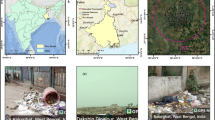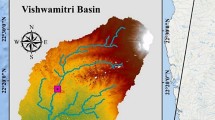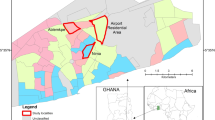Abstract
Although certain countries have proposed revitalization to address the issue of inefficient industrial parks in recent years, there is little research exploring the causes of inefficient industrial parks—although this would help in formulating improvement strategies and further resource allocation. This study presents an evaluation framework for the causes of inefficient urban industrial parks based on a novel hybrid modified multi-attribute decision-making model in real cases, which includes three dimensions and 10 criteria. Two cases of “industrial parks designated by urban planning” in Taiwan were examined. The results of the Decision-Making Trial and Evaluation Laboratory (DEMATEL) and the DEMATEL technique based on the basic concept of the analytic network process indicated that the parcel dimension (A1) and policy dimension (A3) had more influence on causing inefficiency in industrial parks. The criteria with bigger impact were “property rights (B1),” “size and shape (B2),” “location (B3),” “planning and development mechanisms (B8),” “management mechanisms (B9),” and “spatial planning policy for industry (B10).” The modified Vlse Kriterijumska Optimizacija I Kompromisno Resenje (VIKOR) revealed that policy dimension (A3) and its criteria have relatively poor performance in two cases; solving the policy dimension is the most critical strategy for IPDUP. This presented decision-making model not only identifies the key causes of the inefficient industrial park and further improvements to it, but also provides a direction for evaluating, planning, and developing sustainable industrial parks.



Similar content being viewed by others
Notes
In the beginning, a total of 30 experts were listed, including nine government officials related to planning and management of industrial land, 10 scholars engaged in research about industrial land planning, development, or use in university, and 11 consultants or managers engaged in industrial land planning or development. After invitations were sent by mail, 15 experts, with five covering each field, were willing to be interviewed. They were then informed of the purpose of the investigation in detail by mail or telephone and sent the expert questionnaire by email or fax.
PIP was usually initiated by a government authority (that is, the industrial authority of the Ministry of Economic Affairs, the processing export park management office, or the competent scientific and technological authority), and development work was usually entrusted to the public sector, such as Taiwan Land Development Corporation or China Engineering Corporation. These development sectors could request that government authorities assist in land acquisition to engage in development work. The construction of roads and necessary public facilities has also been provided by these institutions. When development was completed, the development sectors calculate the development costs to present the pre-price for renting or selling the land. The industrial authority of the Ministry of Economic Affairs ultimately declared the final price for renting or selling land, and then management authority (industrial park management units) leased or sold to various vendors and limited its holding years prior to transfer to other parties (Shen 2002). When the vendors transferred the land in later years, the management authority did not interfere with its prices (Lin and Ben 2009).
References
Arabsheibani, R., Sadat, Y. K., & Abedini, A. (2016). Land suitability assessment for locating industrial parks: A hybrid multi criteria decision-making approach using geographical information system. Journal of Geographical Research, 54(4), 446–460.
Chan, A., Cheug, E., & Wong, I. (2015a). Impacts of the revitalizing industrial buildings (RIB) scheme in Hong Kong. Sustainable Cities and Society, 15, 57–63.
Chan, A., Cheug, E., & Wong, I. (2015b). Revitalizing industrial buildings in Hong Kong—A case review. Sustainable Cities and Society, 15, 57–63.
Chapman, K. (2009). Industry location. In H. Yeung (Ed.), International encyclopedia of human geography (pp. 396–401). UK: Elsevier.
Chen, J. Y. (2008). The Urbanization of industrial space: The institutional transplantation of zoning and real estate in Taipei Urban industrial zones. Master’s Thesis of National Taiwan University. (in Chinese)
Chen, T. C., Lin, C. L., & Tzeng, G. H. (2019). Assessment and improvement of wetlands environmental protection plans for achieving sustainable development. Environmental Research, 169, 280–296.
Chen, W., Shen, Y., Wang, Y., & Wu, Q. (2018). The effect of industrial relocation on industrial land use efficiency in China: A spatial econometrics approach. Journal of Cleaner Production, 205, 525–535.
Cheng, W., He, R., & Wu, Q. (2017). A novel efficiency measure model for industrial land use based on subvector data envelope analysis and spatial analysis method. Complexity, 10, 1–11.
Coase, R. H. (1960). The problem of social cost. Journal of Law and Economics, 3, 1–44.
Dan, T., & Huang, X. (2008). Influencing factors of the levels of intensive use of typical industrial land. China Population, Resources and Environment, 18(3), 54–57.
Danilo, V. D. (2018). The evolution process of Chicago’s industrial land-use policy. Urban Research & Practice, 11(4), 478–491.
Ferm, J., & Jones, E. (2016). Mixed-use ‘regeneration’ of employment land in the post-industrial city: challenges and realities in London. European Planning Studies, 24(10), 1913–1936.
Fernández, I., & Ruiz, M. C. (2009). Descriptive model and evaluation system to locate sustainable industrial areas. Journal of Cleaner Production, 17, 87–100.
Fonseca, F., & Ramos, A. R. (2019). Vacant industrial buildings in Portugal: A case study from four municipalities. Planning Practice and Research, 34(3), 239–254.
Gao, Y., & Ma, Y. (2015). What is absent from the current monitoring: Idleness of rural industrial land in suburban Shanghai. Habitat International, 49, 138–147.
Gölcük, I., & Baykasoĝlua, A. (2016). An analysis of DEMATEL approaches for criteria interaction handling within ANP. Expert Systems with Applications, 46, 346–366.
Guild, R. L. (2000). Infrastructure investment and interregional development: Theory, evidence, and implications for planning. Public Works Manage. Policy, 4(4), 274–285.
Hodgkinson, A., Nyland, C., & Pomfret, S. (2001). The determination of location in New South Wales. Regional Studies, 35(1), 39–55.
Hsieh, J. C., & Lin, S. H. (2016). Pricing strategies for leasing non-public-use land. Habitat International, 53, 18–29.
Hsu, J. Y. (2004) Study on industrial land policy and production efficiency in Taiwan, Doctor’s Thesis of National Chengchi University. (in Chinese).
Hsu, W. C., Tsai, M. H., & Tzeng, G. H. (2018). Exploring the best strategy plan for improving the digital convergence by using a hybrid MADM model. Technological and Economic Development of Economy, 24(1), 164–198.
Hu, K. H., Chen, F. H., & Tzeng, G. H. (2016). Evaluating the improvement of sustainability of sports industry policy based on MADM. Sustainability, 8(7), 606–626.
Hu, S. K., Liou, J. H., Lu, M. T., Chuang, Y. C., & Tzeng, G. H. (2018). Improving NFC technology promotion for creating the sustainable education environment by using a hybrid modified MADM model. Sustainability, 10(5), 1379–1403.
Hu, K. H., Wei, J., & Tzeng, G. H. (2017). Risk factor assessment improvement for China’s cloud computing auditing using a new hybrid MADM model. International Journal of Information Technology and Decision Making, 16(3), 737–777.
Hu, J. L., Yeh, F. Y., & Chang, I. T. (2009). Industrial park efficiency in Taiwan. Journal of Information and Optimization Sciences, 30(1), 63–86.
Huang, K. W., & Tzeng, G. H. (2016). New hybrid multiple attribute decision-making model for improving competence sets: Enhancing a company’s core competitiveness. Sustainability, 8(7), 175–208.
Izadikhah, M., & Saen, R. F. (2015). A new data envelopment analysis method for ranking decision-making units: An application in industrial parks. Expert Systems, 32(5), 596–608.
Jiang, G., Wenqiu, M., Zhou, D., Zhao, Q., & Zhang, R. (2017). Agglomeration or dispersion? Industrial land-use pattern and its impacts in rural areas from China’s township and village enterprises perspective. Journal of Cleaner Production, 159, 207–219.
Lai, Y., Peng, Y., & Lin, Y. (2014). Industrial land development in urban villages in China: A property rights perspective. Habitat International., 41, 185–194.
Li, S. F. (2006). The evolution of an urban plan: The case of the Taichung Harbor special district plan. Master’s Thesis of Feng Chia University.
Lin, L. G. (2017). Gong ye yong di gong xu bu jun ‘tian yuan hua ju luo’ bang nong di gong chang jiu di he fa?
Lin, S. W., & Ben, T. M. (2009). Impact of government and industrial agglomeration on industrial land prices: A Taiwanese case study. Habitat International, 33, 412–418.
Lin, S. H., Liu, K. M., Hsieh, J. C., Hu, C. L., Huang, X., & Tzeng, G. H. (2019). A new hybrid modified MADM model for the potential evaluation of a comprehensive land consolidation project (LCP) toward achieving sustainable development. Journal of Environmental Planning and Management. (Forthcoming)
Liou, J. H., Tamošaitienė, J., Zavadskas, E. K., & Tzeng, G. H. (2016). New hybrid COPRAS-G MADM Model for improving and selecting suppliers in green supply chain management. International Journal of Production Research, 54(1), 114–134.
Liu, C. H. (2018). Schemes for enhancing Taiwanese cruise PAK relationships using the hybrid MADM model. Tourism Management, 69, 510–522.
Liu, K. M., Lin, S. H., Hsieh, J. C., & Tzeng, G. H. (2018a). Improving the food waste composting facilities site selection for sustainable development using a hybrid modified MADM model. Waste Management, 75, 44–59.
Liu, M. T., Lu, S. K., Huang, L. H., & Tzeng, G. H. (2015). Evaluating the implementation of business-to-business m-commerce by SMEs based on a new hybrid MADM model. Management Decision, 53(2), 290–317.
Liu, Y., Chen, Y., & Tzeng, G. H. (2017). Identification of key factors in consumers’ adoption behavior of intelligent medical terminals based on a hybrid modified MADM model for product improvement. International Journal of Medical Informatics, 105, 68–82.
Liu, Y., Wang, H., & Tzeng, G. H. (2018b). From measure to guidance: Galactic model and sustainable development planning toward the best smart city. Journal of Urban Planning and Development, 144(4), 04018035.
Lu, M. T., Hu, S. K., Huang, L. H., & Tzeng, G. (2015). Evaluating the implementation of business-to-business m-commerce by SMEs based on a new hybrid MADM model. Management Decision, 53(2), 290–317.
Ma, K. F. (1999). A study on development-efficiency of industrial districts and industrial zone in Taiwan. Master’s Thesis of National Chengchi University. (in Chinese).
Meng, Y., Zhang, F. R., Ana, P. L., Dong, M. L., Wang, Z. Y., & Zhao, T. (2008). Industrial land-use efficiency and planning in Shunyi, Beijing. Landscape Urban and Planning, 85, 40–48.
Mesthrige, J. W., & Poon, H. L. (2015). Assessing the impact of revitalized old industrial buildings on the value of surrounding properties: An empirical study. Facility, 33(3), 245–261.
Mesthrige, J. W., Wong, J. K. W., & Yuk, L. N. (2018). Conversion or redevelopment? Effects of revitalization of old industrial buildings on property values. Habitat International, 79, 53–64.
Newell, T. A. (2009). Development and neighborhood revitalization: The effects of residential investment on property values in Durham. NC. Michigan Journal of Business, 3(2), 97–120.
Opricovic, S., & Tzeng, G. H. (2004). Compromise solution by MCDM methods: A comparative analysis of VIKOR and TOPSIS. European Journal of Operational Research, 156(2), 445–455.
Opricovic, S., & Tzeng, G. H. (2007). Extended VIKOR method in comparison with outranking methods. European Journal of Operational Research, 178(2), 514–529.
Ou Yang, Y. P., Shieh, H. M., Leu, J. D., & Tzeng, G. H. (2008). A novel hybrid MCDM model combined with DEMATEL and ANP with applications. International Journal of Operations Research, 5(3), 160–168.
Ou Yang, Y. P., Shieh, Y. P., & Tzeng, G. H. (2013). AVIKOR technique based on DEMATEL and ANP for information security risk control assessment. Information Sciences, 232, 482–500.
Peng, K. H., & Tzeng, G. H. (2019). Exploring heritage tourism performance improvement for making sustainable development strategies using the hybrid-modified MADM model. Current Issues in Tourism, 22(8), 921–947.
Ramos, R. A. R., & Fonseca, F. P. (2016). A methodology to identify a network of industrial parks in the Ave valley. Portugal. European Planning Studies, 24(10), 1844–1862.
Reisi, M., Afzali, A., & Aye, L. (2018). Applications of analytical hierarchy process (AHP) and analytical network process (ANP) for industrial site selections in Isfahan, Iran. Environmental Earth Sciences, 77(14), 537.
Rives, J. M., & Heaney, M. T. (1995). Infrastructure and local economic development. Regional Economic Perspectives, 25, 58–73.
Ruiz, M. C., Romero, E., Pérez, M. A., & Fernández, I. (2012). Development and application of a multi-criteria spatial decision support system for planning sustainable industrial areas in Northern Spain. Automation in Construction, 22, 320–333.
Saaty, T. L. (1980). The analytic hierarchy process. New York: McGraw-Hill.
Saaty, T. L. (1996). The analytic network process. Pittsburgh: RWS Publications.
Shen, K. Y., & Tzeng, G. H. (2015). A new approach and insightful financial diagnoses for the IT industry based on a hybrid MADM model. Knowledge-Based Systems, 85, 112–130.
Shen, K. Y., & Tzeng, G. H. (2018). Advances in multiple criteria decision making for sustainability: Modeling and applications. Sustainability, 10(5), 1600–1605.
Sun, Y., Ma, A., Su, H., Su, S., Chen, F., Wang, W., et al. (2020). Does the establishment of development zones really improve industrial land use efficiency? Implications for China’s high-quality development policy. Land Use Policy, 90, 104265.
Tang, B., & Ho, W. (2015). Land-use planning and market adjustment under de-industrialization: Restructuring of industrial space in Hong Kong. Land Use Policy, 43, 28–36.
Tu, F., Yu, X., & Ruan, J. (2014). Industrial land use efficiency under government intervention: Evidence from Hangzhou, China. Habitat International, 43, 1–10.
Tzeng, G. H., & Shen, K. Y. (2017). New concepts and trends of hybrid multiple criteria decision making. Florida: CRC Press.
United Nations Industrial Development Organization (2012) Europe and Central Asia regional conference on industrial parks as a tool to foster local industrial development. Baku: Author.
Weber, A. (1909). Theory of the location of industry. Chicago: University of Chicago Press.
Xie, H., Wang, W., Yang, Z., & Choi, Y. (2016). Measuring the sustainable performance of industrial land utilization in major industrial zones of China. Technological Forecasting and Social Change, 112, 207–219.
Yang, Z., Hao, G., & Zheng, Z. (2018). Investigating operations of industrial parks in Beijing: efficiency at different stages. Economic Research-Ekonomska Istraživanja, 31(1), 755–777.
Ye, L., Huang, X., Yang, H., Chen, Z., Zhong, T., & Xie, Z. (2018). Effects of dual land ownerships and different land lease terms on industrial land use efficiency in Wuxi City, East China. Habitat International, 78, 21–28.
Yin, Y. H. (2018). jia que di zhen chao di? tai shang hai mei hui liu ,gong ye yong di jia ge biao tian jia,zuo hang tai ke ji ye zuan bu hui lai. Retrieved November 09, 2019 from https://www.storm.mg/article/728990. (in Chinese).
Zhao, X., Zhang, L., Huang, X., & Zhang, Y. (2018). Evolution of the spatiotemporal pattern of urban industrial land use efficiency in China. Sustainability, 10(7), 2174–2186.
Acknowledgements
This work was supported by Major Program of the National Social Science Foundation of China (Grant No. 17ZDA061) and National Natural Science Foundation of China (Grant Nos. 41701608 and 41771189). The authors also thank Mr. Chen Li,-Wei and Mr. Liu, Kung-Ming for useful help for data collection.
Author information
Authors and Affiliations
Corresponding author
Additional information
Publisher's Note
Springer Nature remains neutral with regard to jurisdictional claims in published maps and institutional affiliations.
Appendices
Appendix 1: Schematic diagram and evaluation form in questionnaire
See Tables 4, 5, and 6 and Fig 4.
Appendix 2: Informations of empirical cases
See Table 7.
Appendix 3: Calculated result related to influence relation matrix
Rights and permissions
About this article
Cite this article
Lin, SH., Wang, D., Huang, X. et al. A multi-attribute decision-making model for improving inefficient industrial parks. Environ Dev Sustain 23, 887–921 (2021). https://doi.org/10.1007/s10668-020-00613-4
Received:
Accepted:
Published:
Issue Date:
DOI: https://doi.org/10.1007/s10668-020-00613-4





